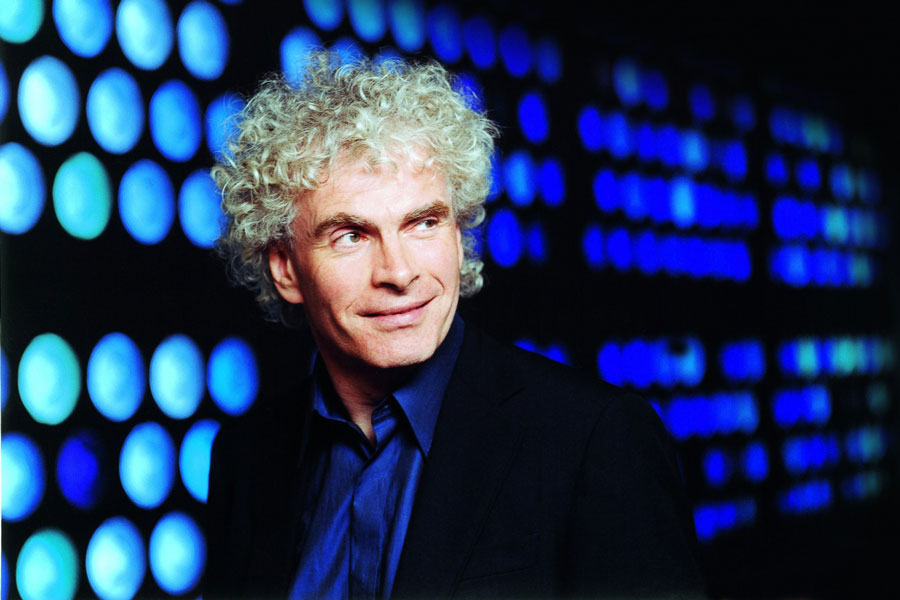Now in its twelfth decade, The London Symphony Orchestra was the first British orchestra owned by its players. The ensemble is self-governing and made up of nearly a hundred musicians who also perform as soloists and in chamber groups at LSO St Luke's. The LSO was one of the first orchestras to make gramophone records and film scores and has more recordings to its name than any other orchestra in the world to date. Additionally, the LSO was the first to have its own peak-time television series, which it still enjoys. Their principle conductors include Sir Simon Rattle as Music Director, Gianandrea Noseda, Michael Tilson Thomas as Conductor Laureate, and André Previn as Conductor Emeritus.
Simon Rattle took up his position as Music Director of the LSO in September 2017. He was awarded a Knighthood by Her Majesty the Queen in 1994 and received the Order of Merit in the 2014 New Year’s Honours. In 2012 he led the Orchestra at the Opening Ceremony of the London Olympic Games. Sir Rattle previously served as Guest Conductor of the Rotterdam and Los Angeles Philharmonic Orchestras and Music Director of the City of Birmingham Symphony Orchestra. In 2002, he became Chief Conductor and Artistic Director of the Berliner Philharmoniker, a post he held until the end of the 2017-2018 season.
Béla Bartók composed Music for Strings, Percussion, and Celesta in 1936. Swiss conductor, Paul Sacher led the first performance in Basel on January 21, 1937. Sacher, a collector, composer, and billionaire philanthropist contributed considerably to the shaping of 20th-century music, commissioning works by remarkable composers including Richard Strauss, Hindemith, Stravinsky, Honegger, Martinů, and Tippett. When Bartók accepted Sacher’s request for a piece to celebrate the 10th anniversary of the Basel Chamber Orchestra, the composer said he was thinking of writing a work for strings and percussion.
Bartók's passion for the asymmetrical, driving rhythms of folk music deeply affected his compositional style as did his great admiration for the polychromatic textures of the orchestral work of his contemporaries. Thus, creative variations in rhythm and texture come to fruition in Music for Strings, Percussion, and Celesta. A slow fugue is the basis for the first movement, however, unlike Bach, Bartók uses a chromatic motif and rejects the formal key structure by excluding a key signature from the score. The third movement, sometimes referred to as Bartók’s night music, is punctuated by inventive uses of percussion and was famously used in Stanley Kubrick's 1980 adaption of Stephen King's, novel, The Shining. Timpani and pizzicato strings open the final movement with folk rhythms and melodies interspersed between episodes of the original fugue motif.
Beyond the unusual instrumentation, the most captivating detail of the composition is Bartók’s specifications for the distribution of the instruments on stage. The strings are divided into two equal groups, which mirror each other and operate as separate ensembles, often playing antiphonally. The other instruments fill the centre of the stage. In front of the conductor and slightly to the left is the piano, with the celesta beyond. On the conductor’s centre-right, mirroring the keyboard group are the harp, xylophone, and additional percussion. At a time before the invention of stereophonic sound, Music for Strings, Percussion, and Celesta reignited a fascination with spatially separated musicians. This technique was extorted by American radio orchestras in the early 1950s when stereo speakers became available. At the time of its composition, however, the phenomena could only be experienced at a live performance.
Anton Bruckner’s Sixth Symphony was composed between 1879 and 1881, he completed the first movement on September 27, 1880, the second in November, the third in the opening month of 1881 and the finale on September 3 of that year. The Sixth Symphony was claimed as the composer’s favourite among his own works, though it was never performed in its entirety during Bruckner's lifetime. Only the middle movements were performed in Vienna in 1883 and they were poorly received by the press. "In Vienna, it is the old story all over again," Bruckner wrote to Hermann Levi. "I almost prefer them not to perform my works here. Old friends have become hostile again, etc. In a word: the same old atmosphere and treatment. Without Hanslick's approval, nothing is possible in Vienna."
Bruckner was notoriously lacking in confidence and self-appointed mentors frequently assisted him in editing his symphonies. This has proven quite problematic to later generations since most of his works exist in several different versions. Luckily, the Sixth Symphony exists only in one manuscript. Thus, when this record was uncovered, in 1939, it became possible to correct the numerous inaccuracies and inconsistencies that inhabited the previous editions. Mahler conducted an abbreviated version of the piece after the composers’ death, however, an unaltered version was not performed until 1901.
Alixandra Porembski, English Language Annotator

